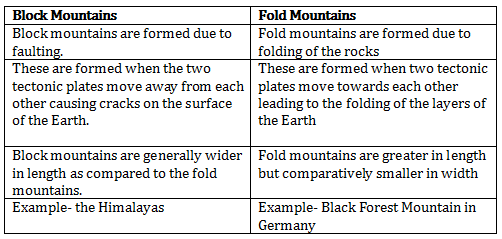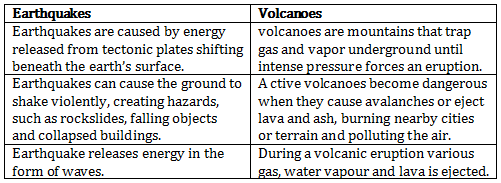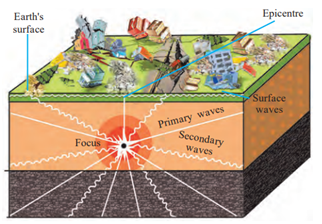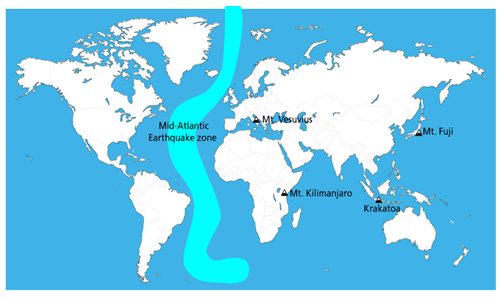Class 9 MAHARASHTRA STATE TEXTBOOK BUREAU Solutions Social Studies Chapter 2 - Endogenetic Movements
Endogenetic Movements Exercise 20
Solution 1(a)
ii. Velocity
Solution 1(b)
ii. Tension
Solution 1(c)
ii. Tension
Solution 1(d)
ii. The Himalayas
Solution 1(e)
ii. Continent building
Solution 2(a)
The Himalayas are prone to earthquakes. During an earthquake, energy is released from the interior of the earth in the form of waves. The primary or the P waves are the first to reach the surface of the earth. They move forward and backward. It is because of these waves that buildings move forward and backward.
Solution 2(b)
The Meghalaya plateau has been formed due to the slow movements while the Deccan Plateau has been formed due to the sudden movements.
When a part of the earth's crust in between two parallel faults is lifted, it looks like a block. The Meghalaya plateau has been formed due to this fault movement.
The Deccan Plateau has been formed due to the deposition of lava which erupted from a volcanic eruption.
Solution 2(c)
- The plate boundaries are directly related to the areas of volcanoes. Most of the volcanoes are located on the plate boundaries.
- The part of the plate boundary which slides under the crust, results in the loss of material. Such boundaries are called plate consuming boundaries.
- In areas where new material (magma) is coming up onto the Earth's crust, they are called plate creating boundaries.
- Both the processes result in earthquakes and volcanoes. Thus, most of the volcanoes are formed in the plate boundaries.
Solution 2(d)
- Barren is land has a volcano which has recently become active. It is conical in shape
- Mainly dust, smoke and mud come out of this eruption along with some lava.
- During eruption, the lava is spread around the mouth of this vent, when it comes out.
- As a result, a cone-shaped mountain starts forming.
Solution 2(e)
- Most earthquakes directly under a volcano are caused by the movement of magma.
- The magma exerts pressure on the rocks until it cracks the rock. Then the magma gushes out into the crack and starts building pressure again.
- This causes a lot of instability within the crust of the Earth which would also lead to the release of pressure in the form of seismic waves or tremors causing earthquakes.
Solution 3(a)
Sudden movements
Solution 3(b)
Slow movements-Mountain building movement
Solution 3(c)
Sudden movements
Solution 3(d)
The slow movement - Upward - Downward Movement.
Solution 5
Block Mountains and fold mountains

Primary and Secondary Seismic Waves

Earthquakes and volcanoes

Solution 6(a)
- Due to the movements taking place in the earth's interiors, great tension is created in the earth's crust.
- When this tension goes beyond limits, energy is released in the form of waves which shakes the earth's surface causing an earthquake.
Solution 6(b)
- Fold mountains are formed due to the slow movements. In folding, since the compressional forces acts from two opposite sides towards the center, the land in the center rises up in a series of fold.
- Under the earth's surface, when energy waves work towards each other in the horizontal direction, the layer of soft rock forms fold. As a result, the surface of the earth gets uplifted leading to the formation of the fold mountains.
Solution 6(c)
- The higher magnitude of an earthquake is more devastating.
- Earthquake of higher magnitude releases greater energy in forms of seismic waves.
- The S waves scatter in all directions from the focus of the earthquake.
- The particles lying in the way of these waves move up and down in the direction of energy transfer. The buildings on the earth move up and down because of these waves resulting into its collapse.
Solution 6(d)
Effects of an Earthquake
- It causes cracks and fractures on the ground. It may result in sliding of rocks causing landslides.
- Some areas may get submerged and some may get uplifted. This may displace people.
- Tsunamis can be generated in the oceans due to the earthquakes. It causes great loss of lives and property.
- If an earthquake takes place in a snow-covered areas, avalanches may occur.
- Earthquake causes tremendous loss to lives and property. Many people get killed and injured during an earthquake.
Solution 6(e)
There are three types of seismic waves. These are:
Primary Waves: These are the first waves to reach the surface of the earth. These can travel through all the three states-liquid, solid and gaseous. They move forward and backward. It is because of these waves that buildings move forward and backward.
Secondary Waves: The Secondary waves or the S waves reaches the surface of the earth after the P waves. These waves also scatter in all directions from the focus of the earthquake. These waves are more destructive than the 'P' waves.
Surface or 'L'Waves: They are generated after 'P' and 'S' waves reach the epicenter. They travel in the direction of the circumference of the earth along the crust. These waves are also highly destructive.
Solution 6(f)
The types of volcanoes on the basis of periodicity of eruption with examples are:
Active Volcanoes: Active volcanoes are those which have erupted in the recent past and are likely to erupt in the future. There are about 550 known active volcanoes. Some of the active volcanoes are Mt. Etna in Italy and Mauna Loa in Hawaii.
Dormant Volcano: Those volcanoes which have not erupted in the recent historical past but can become active at any time are known as dormant volcanoes. Example: Mt. Kilimanjaro in Africa and Mt. Vesuvius in Italy.
Extinct Volcano: Volcanoes which have not erupted in the present geological period and are not likely to erupt in the future are known as extinct volcanoes. Example- Mt. Aconcagua in South Africa and Mt. Kenya in Africa.
Solution 7

Solution 8


